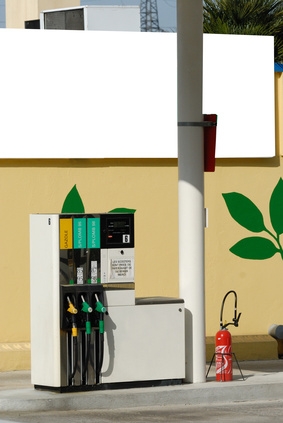
CNG stands for "compressed natural gas" and represents one of the two ways natural gas can act as fuel for transportation vehicles--the other being liquefied natural gas, or LNG. The U.S. Energy Policy Act of 1992 regards CNG as an alternative fuel due to its cleaner burn compared to gasoline or diesel. Other characteristics of CNG regarding availability and an already established distribution infrastructure have further raised its stock as an alternative fuel in the U.S. and the rest of the world.
The majority of natural gas comes from fossil fuels stored in stone reservoirs under the earth's surface. Such fuels are extracted through drilling and processed to separate the gas from any liquids or contaminants. The gas is then put into steel or aluminum tanks under enormous pressure--about 3,100 to 3,600 pounds per square inch (psi)-- for vehicles to use as fuel. Once in the vehicle, a regulator usually depressurizes the gas to a set psi before entering the engine's combustion chamber.
Emissions constitute one of the biggest advantages of CNG. Natural gas mostly comprises methane, a hydrocarbon with plenty of hydrogen and a relatively low share of carbon, which in part makes natural gas among the cleanest burning fuels, according to the U.S. Department of Energy (DOE). Gasoline-powered vehicles can easily use CNG fuel via a retrofit--diesel vehicles, less so. Lower costs characterize CNG as well: According to the DOE's Alternative Fuel Price Report for October 2009, on average, CNG costs about $0.78 cents less than gasoline and $0.71 cents less than diesel on a per gallon equivalent basis.
Although several companies and state governments have adopted CNG in various vehicles--from taxicabs to medium-duty trucks to street sweepers--few mass-produced natural gas vehicles for consumers have been manufactured, with the Honda Civic GX CNG being the only such offering as of April 2010. The number of fuel stations equipped to supply natural gas as fuel still pale in comparison to gasoline and diesel stations, despite making in-roads in markets like California, according to the state's energy commission. Lack of space to fit in CNG tanks in the vehicle represents another potential issue, especially in retrofitted models. In developing countries, the financial hurdles involved in setting up an adequate infrastructure are also an issue, according to a United Nations report.
A big attraction for alternative fuel systems like CNG and LNG in the United States is that the U.S. produces most of its natural gas. This means that efforts to foster the usage of CNG vehicles dovetail with the nation's aim to increase energy security and reduce vulnerability to supply disruptions in its petroleum imports. The U.S. also has a robust natural gas infrastructure already in place, with approximately 300,000 miles of transmission pipelines distribute the gas all throughout the mainland.
Natural gas also serves as sort of a bridge technology between conventional fossil fuels, like gasoline and diesel, and virtually pollution-free systems like hydrogen fuel cells, which is still some decades off. The U.S. Department of Energy (DOE), for example, is banking on adoption of natural gas to pave the way for fuel cells later on. The gaseous nature of CNG and fuel cell systems may also serve as an aid to the transition, according to the agency